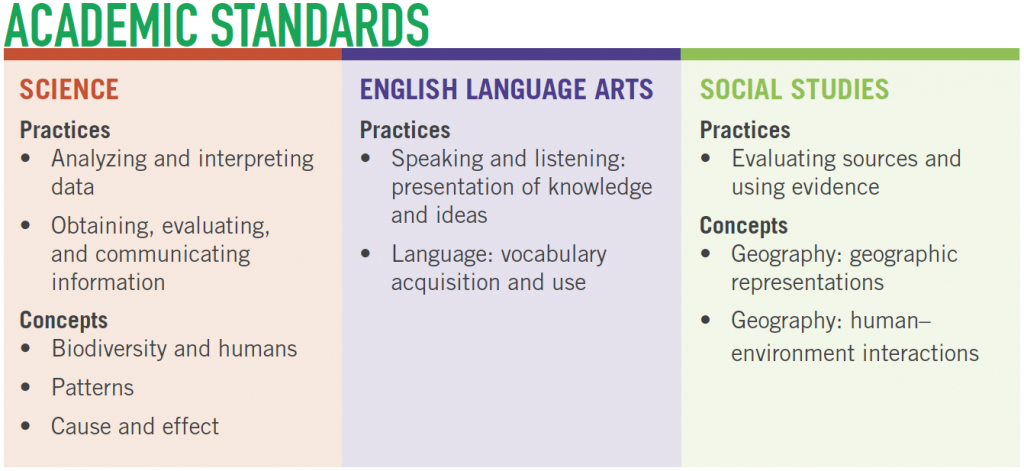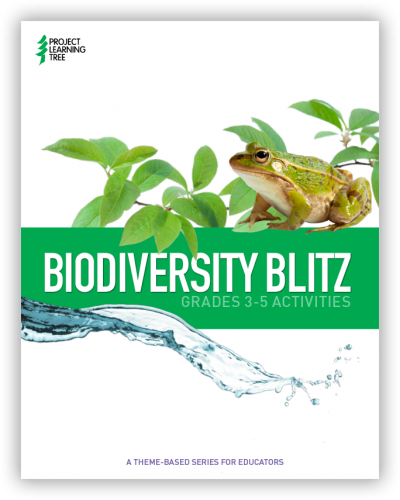November 8, 2020
Project Learning Tree is excited to launch a new series of theme-based activity collections that focus on specific grade levels and topics.
Biodiversity Blitz is the third collection of activities to be released as part of this new themed series for educators. It features three PLT activities for educators of students in grades 3-5 that invite learners to investigate variability among species in an ecosystem, and how this variability – or biodiversity – helps sustain life on Earth.
The activity collection is available for purchase from PLT’s Shop as a downloadable PDF for $5.95.
PLT recently released Discover Your Urban Forest for grades 6-8 and Sensational Trees for grades K-2.
The Diversity of Life
One of Earth’s most valuable resources is its biodiversity, the variety of species that live here. Biodiversity is reflected in the wide range of ecosystems and species on Earth and in the genetic diversity within and among species. Biologists estimate that Earth’s current biodiversity is somewhere between 10 million and 1 trillion different species, living in a range of biological communities.
Biodiversity is one of the most important indicators of an ecosystem’s health. That is because biological richness means organisms have more options to get the food and other resources they need. And greater biodiversity means a greater ability to cope with change. Even if some species face food shortage, habitat loss, climate change, or other threats, the ecosystem as a whole is more likely to sustain itself.
Humans, like other organisms, depend on biodiversity to live. Diversity within and among species provides us with a variety of food, wood, fibers, energy, raw materials, chemicals, and medicines and contributes hundreds of billions of dollars yearly to the world economy.
Biodiversity Blitz: Grades 3-5 Activities
Biodiversity Blitz features three PLT activities for educators of students in grades 3-5. Designed to be flexible, the activities can be used as individual, stand-alone lessons, or all together as a cohesive unit of instruction using a storyline technique.
1. Discover Diversity
Students imagine that they are visitors from outer space, viewing life on Earth for the first time. As they describe the life they find in a small plot, they will become more aware of the diversity of life.
2. Charting Biodiversity
Students explore different ways that organisms are adapted for survival. This activity helps students understand why there are so many different species on Earth.
3. Web of Life
By conducting research and modeling a food web, students learn how diverse organisms are connected in a forest or other ecosystem.
Learning Progressions
Storylines provide connectedness and continuity to individual activities and can serve as the instructional glue that holds areas of knowledge and skills together. The activities in Biodiversity Blitz may be linked together into a unit of instruction using a storyline technique, such as the one that follows.
Guiding Question: What is biodiversity and why is it important?
Storyline: Students investigate to find out ways that species are adapted for survival and how the biodiversity of species in an ecosystem contributes to its stability.
The sequence of individual activities supports this storyline:
- Begin the unit with “Discover Diversity” to give students an opportunity to observe the diversity of life in a small plot of land. Encourage them to compare their data with others to help them determine what factors influence both abundance and diversity.
- Use “Charting Biodiversity” to help students understand why there is such diversity in species on Earth. In the activity, students organize organisms according to their adaptations, and identify species that meet specific criteria. Challenge them to consider why there are so many different species and the value of biodiversity.
- “Web of Life” involves students in researching different species to find out their specific needs for survival, and then using those species to model a food web. Through the model, students can see that the more diverse the ecosystem, the more stable it is.
New Features Within Each Activity
In addition to the typical elements that educators have come to rely on from PLT, the following new features in our theme-based series will further help educators adapt the activities for specific groups and settings.
Academic Standards
Classroom educators and nonformal educators alike need to ensure that instruction helps diverse learners meet rigorous academic benchmarks. Each PLT activity displays explicit connections to practices and concepts mandated by the following national academic standards.
Here is an example from “Discover Diversity”:

Take It Outside!
Describes how to extend student learning into the outdoors.
Differentiated Instruction Strategies
- Cooperative Learning
- ELA Skills
- Hands-On Learning
- Higher-Order Thinking
- Multiple Solution Pathways
- Nonlinguistic Representations
- Personal Connections
- Student Voice
Did You Know?
Forest Facts present interesting insights into forests as global solutions for environmental, economic, and social sustainability.
 Career Corner
Career Corner
Introduces youth to forest-related careers.

Purchase Biodiversity Blitz now from PLT’s Shop for $5.95.






